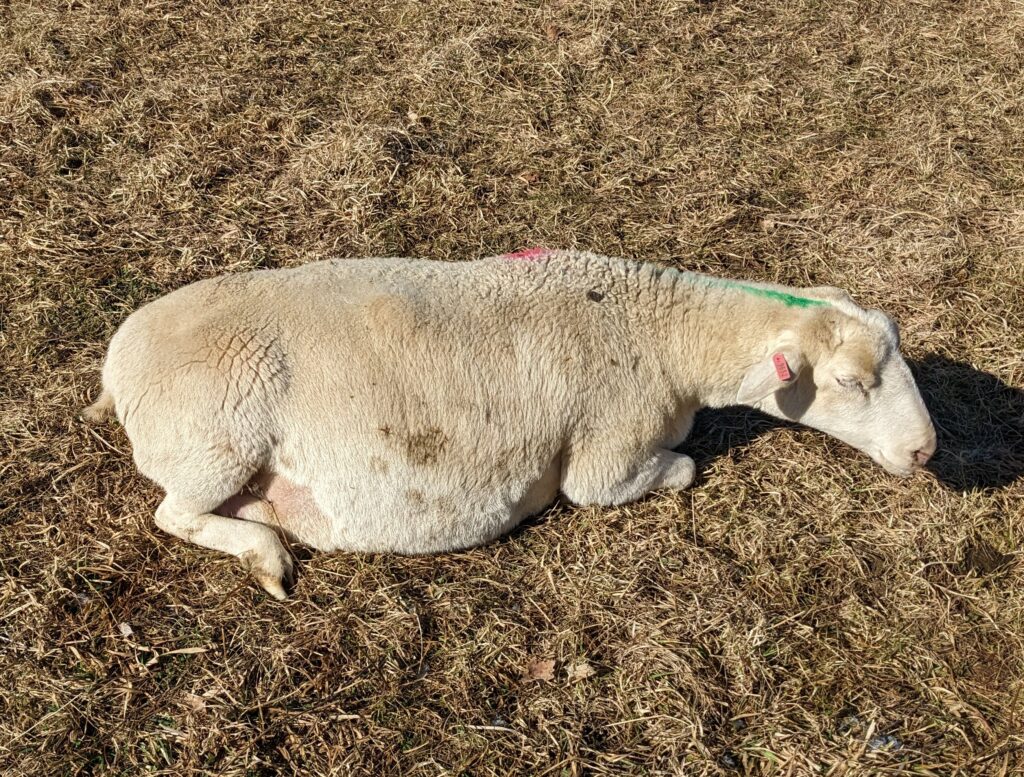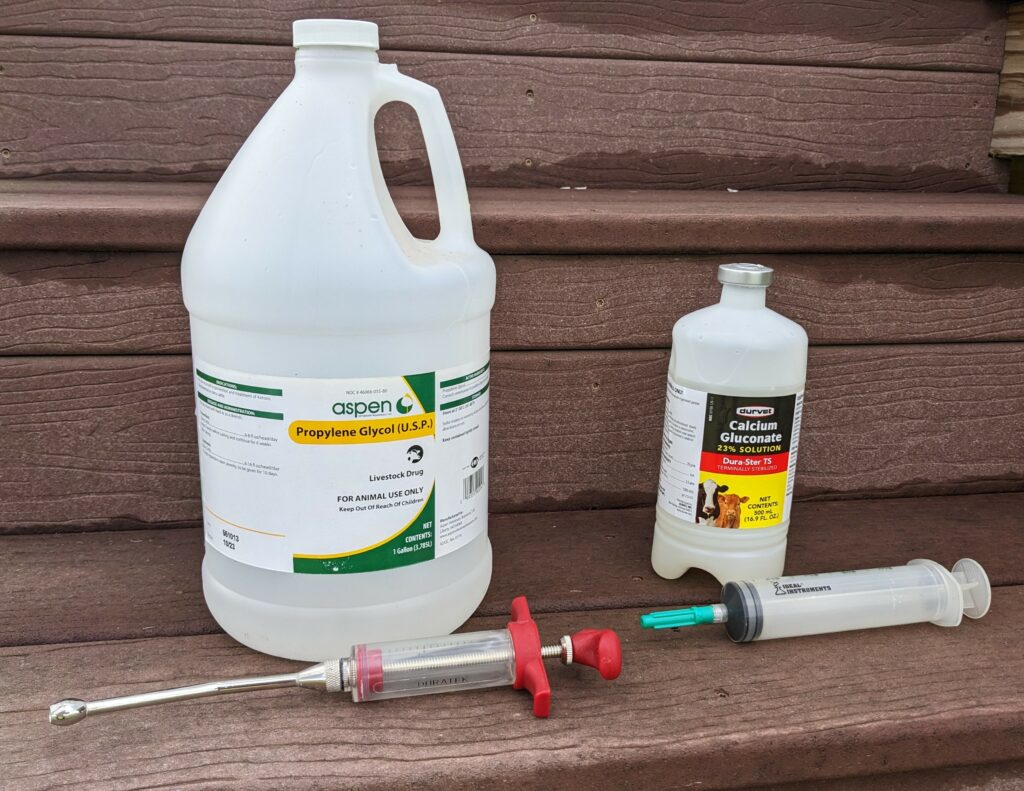Hypocalcemia versus Pregnancy Toxemia in Sheep
A downed sheep is a dead sheep.
Towards the end of pregnancy, a ewe may go down and will be unable to get back up. Common perception is when a sheep is down, it will die. It doesn’t have to be that way.

This ewe went down but got back up after treatment with calcium gluconate and propylene glycol. (Ulf Kintzel / White Clover Sheep Farm)
A pregnant ewe just weeks from giving birth going down and being unable to get back up may either be down because of hypocalcemia (milk fever) or pregnancy toxemia (twin lamb disease, ketosis). Hypocalcemia is an inability to mobilize calcium from the bones fast enough or a lack of calcium in the feed and thus the muscles don’t function properly. The ewe may show a stiff and uncoordinated gait before going down, then often showing occasional muscle tremors and trembling. Pregnancy toxemia occurs when a lack of nutrition leads to rapidly dropping blood glucose (sugar) levels. Such ewe may appear “off” in her behavior, stop eating, separate herself from the flock and eventually go down. She may also just have tremors like a sheep with hypocalcemia before she goes down.
The symptoms between hypocalcemia and pregnancy toxemia are often strikingly similar. How can you distinguish between the two at that stage? It is likely you cannot. I too can’t prior to treatment. This may be the time to call a vet. However, vets with good knowledge about sheep are in many parts of the country in short supply. Some will tell you that their educational focus in college was on cats and dogs and perhaps other pets but not on large animals. Meanwhile, time is of the essence. The longer you wait, the less likely it becomes that the ewe will get back up and will indeed die. For treatment to be successful, it is necessary to be given the same day the ewe goes down, ideally just as soon the ewe goes down. Blood tests can possibly give a conclusive answer but then again you have the time issue and now in addition a cost issue as well.
The answer to the dilemma is simple: you treat for both. Treatments for these conditions are rather easy and fairly inexpensive. Treatments for both conditions don’t interfere with each other. Both conditions can even happen simultaneously.
Hypocalcemia is treated with calcium gluconate. Calcium gluconate can be purchased from many outfits that sell large animal supplies, possibly including from your local farm store. It is inexpensive and comes in a 500 ml bottle. It is supposed to be given IV (intravenously) but that needs in my view tremendous expertise. I give it under the skin (sq, subcutaneous). Giving meds sq is easy. Meds that are labeled to be given IV or IM (intramuscular, meaning in the muscle) can always be given sq but not necessarily the other way around! I give between 50 to 60 ml under the skin down the sides near the rib cage, often dividing the shot on two injection sites. I have a 60 ml syringe at hand just for that purpose.

Calcium Gluconate (right) is the treatment for milk fever, propylene glycol (left) is a drench treating twin lamb disease.
Pregnancy toxemia is treated with propylene glycol, also available at farm stores and sold without prescription. This medication will be given orally as a drench, twice daily until a few days after the ewe has lambed.
How do you know in the end if it was hypocalcemia or pregnancy toxemia? Sheep with hypocalcemia that are treated with calcium gluconate very often (but not always) show rapid recovery after just one or perhaps two treatments. Treatment for pregnancy toxemia usually does not show such rapid success. However, in the end you would not know with absolute certainty which one it was. But since time is of crucial essence when either condition occurs, saving the animal seems to me more important than knowing with absolute certainty what condition it was.
Some of what I wrote is my experience. However, I want to give credit to a friend of mine in Germany, who is a vet. He specializes in sheep and goats. Today’s technology makes it possible that I can take pictures or a video with my cell phone and send it to him via WhatsApp for his diagnosis.
This article was triggered by a number of sheep having these symptoms at my farm shortly before lambing. In hindsight, it was more likely to be hypocalcemia rather than pregnancy toxemia. The rapid improvement in most sheep after giving calcium gluconate just once or twice suggests that. I have added some feed grade calcium to my mineral mix because of it. Likewise, just before lambing, I use some general-purpose minerals or sheep minerals and mix it in with my trace mineral salt and salt. These minerals contain a small amount of dried distillers’ grains and molasses to increase consumption. Because of this luxury consumption I had I discontinued using these minerals in the first place. However, consuming for a brief period of time far more of their mineral mix than usual is exactly what is needed during the last trimester of pregnancy. These minerals also contain Vitamin D, which is essential for calcium metabolism. In summary, I find it prudent to have some source of calcium in the mineral mix, at least during the last few weeks of pregnancy, when the need for calcium is greatly enhanced due to the rapidly growing lamb(s) in the womb.
Lastly, as a frequent receiver of these calls of a sheep being down or sick for these or many other reasons, I want to stress the importance of establishing a business relationship with a vet prior to something happening. When I get these calls or e-mails, asking for advice, my answer always is to call a vet. I cannot and should not offer any advice over the phone, relying on the (often incomplete) account of the caller. My advice to call a vet is often met with resistance either because of cost or the caller doesn’t know one. The latter reason is easily remedied. Seek a vet in your area and see if he or she has some expertise with sheep. Since veterinarians don’t want to be called for an emergency where they can’t help, they are likely going to tell you when sheep are not their expertise. If that is the case, keep looking for a vet before your next sheep emergency occurs.

